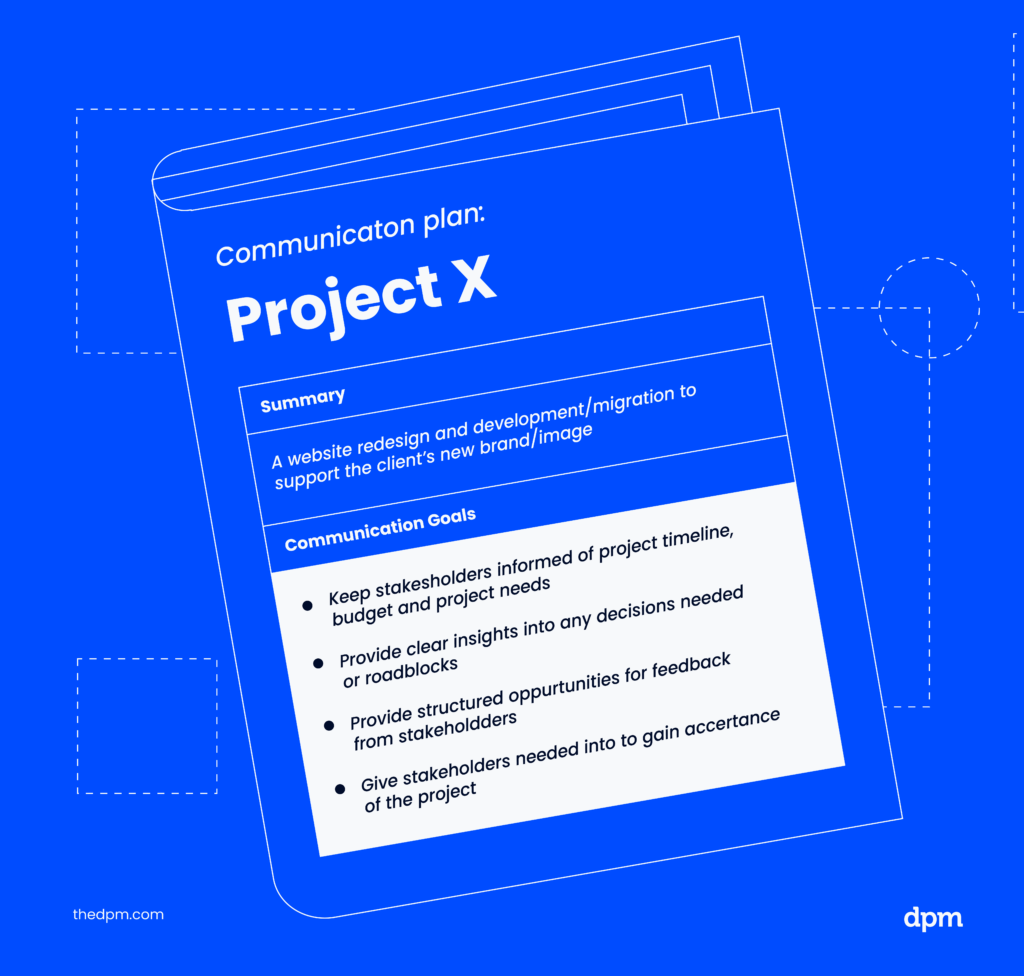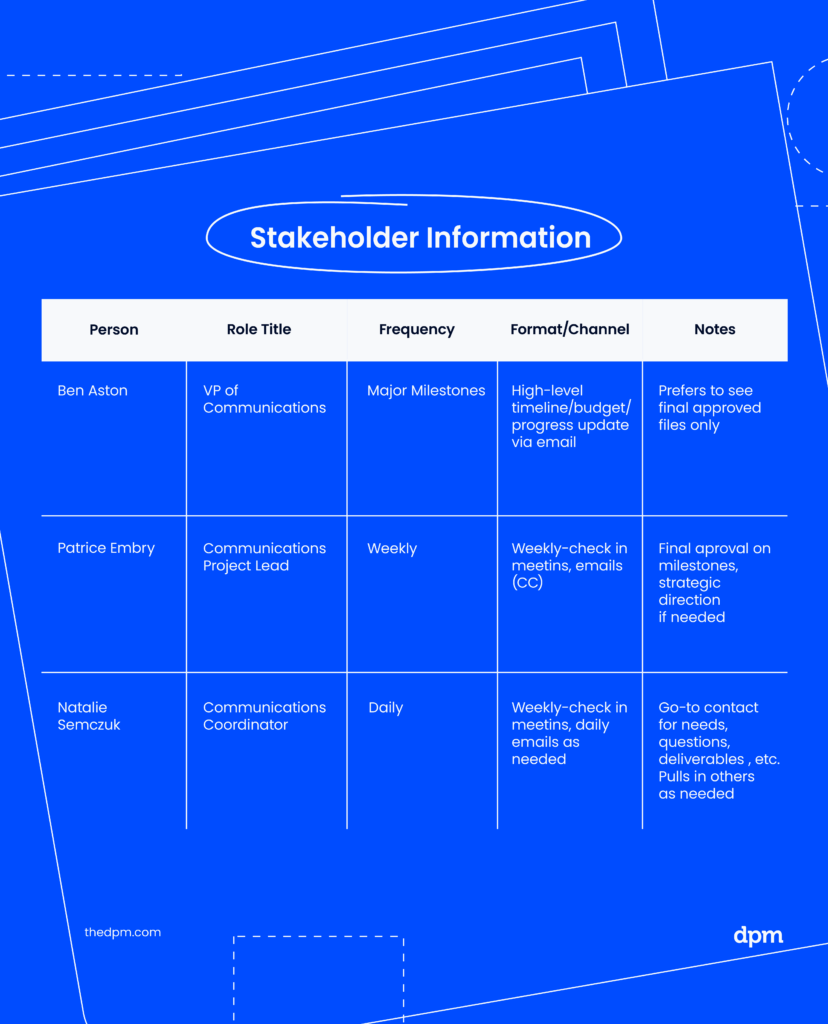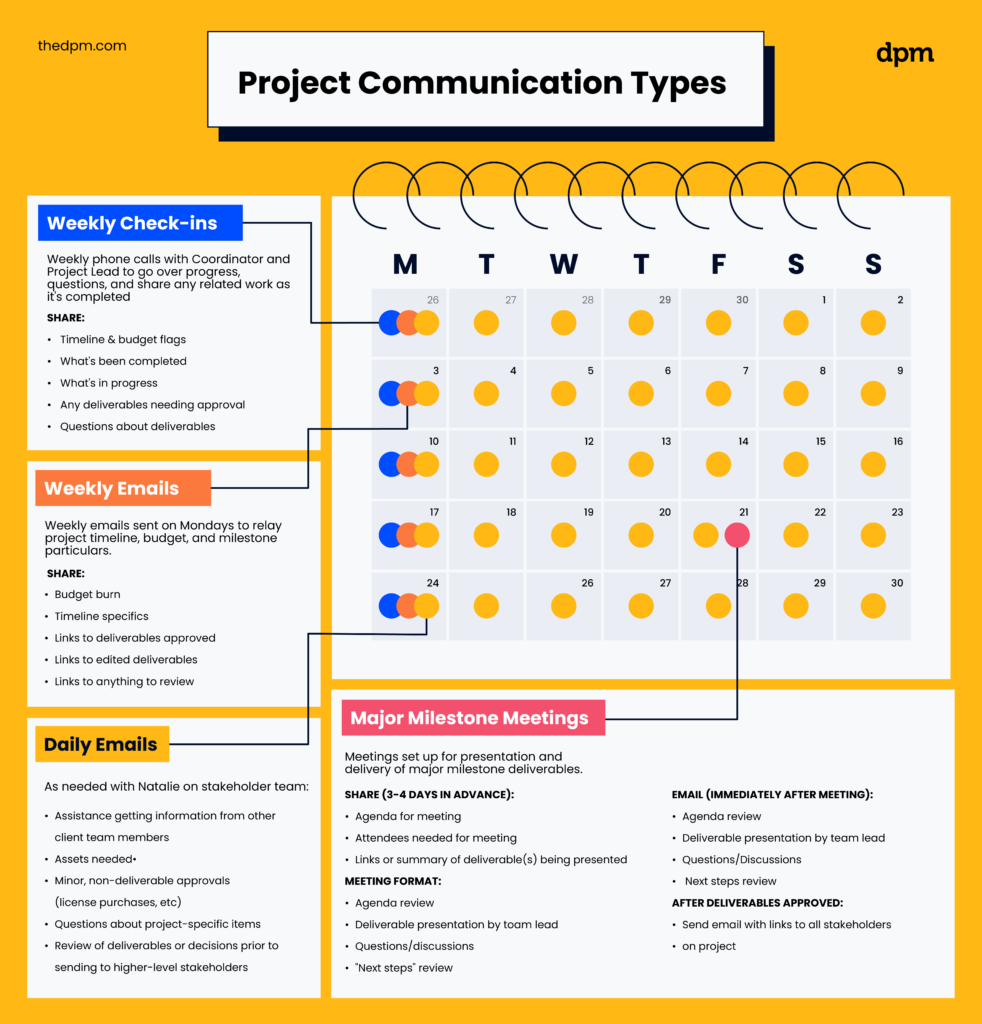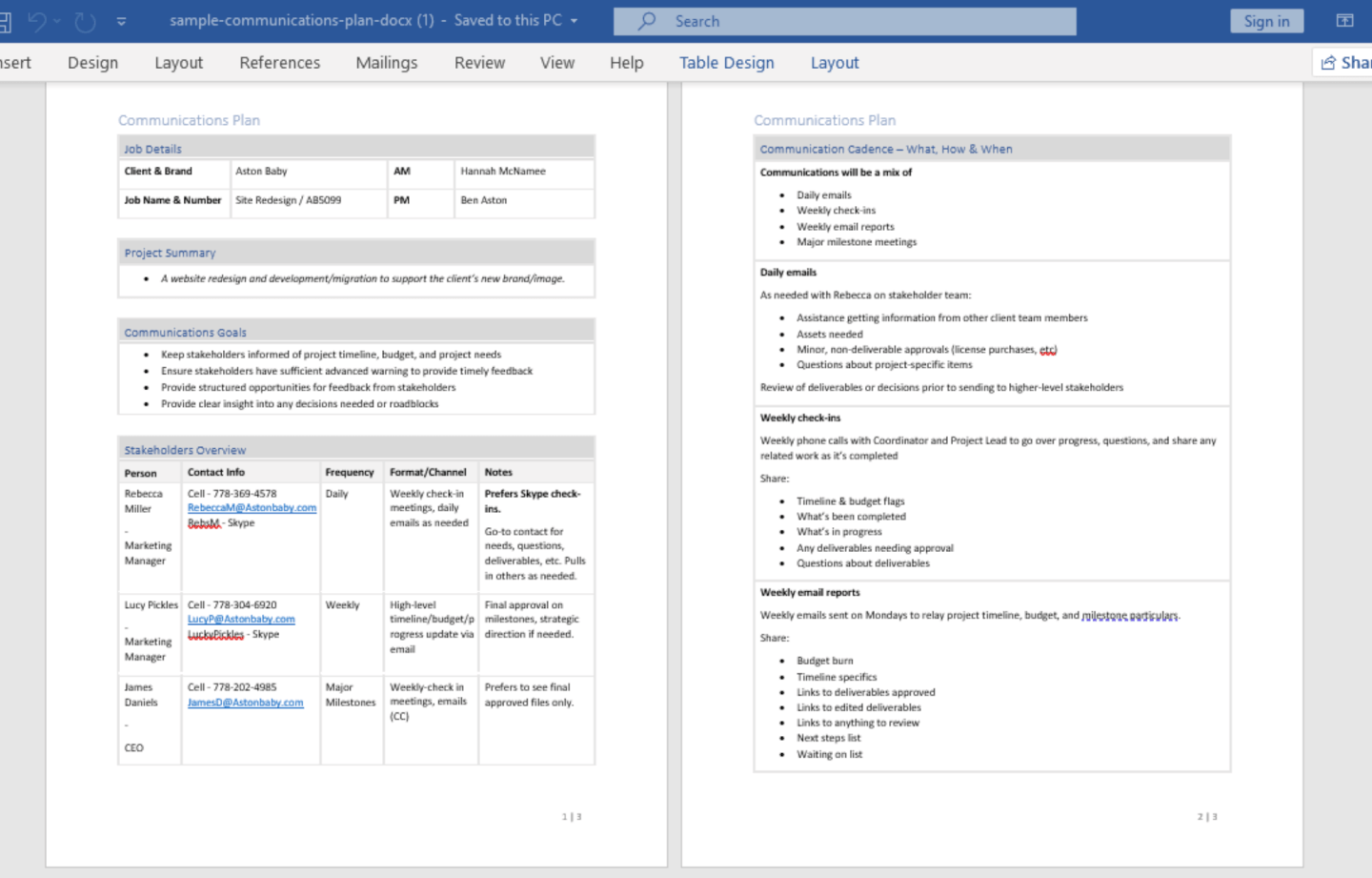Get On The Same Page: A communication plan outlines methods, frequency, and channels for information exchange among project teams and stakeholders, which will ensure alignment and clear expectations for everyone involved.
Harmony with Project Planning: Creating a communication plan goes hand-in-hand with project planning so you can make decisions in advance about how information will be shared, instead of sharing urgent information incorrectly because you didn't have a plan in place.
Templates To The Rescue: Instead of creating your project communication plan from scratch, download our template to speed up the process, or simply copy and paste from an existing project and edit as needed.
A project communication plan helps you strategize about how you intend to communicate with key stakeholders. Without one, you'll struggle to manage stakeholder expectations, keep everyone informed, and prevent chaos amongst your project team.
Here's how to create an effective communication plan, use it to maintain order, and keep your project on the path to success.
What is a Communication Plan?
A communication plan is a strategic blueprint that outlines how information will be exchanged among the project team and stakeholders. It details the methods, frequency, and channels for communication, ensuring everyone involved is informed, aligned, and can collaborate effectively.
In simpler terms, it is like a map that shows how everyone in a project talks to each other, including internal communication between team members. It tells you what each person's communication needs are: who needs to get what type of information, when they need it, and how it will be sent to them.
A project communication plan doesn’t need to be formal, but it should be documented for reference. This ensures everyone knows what's going on, agrees on things, and works well together, especially when working online or with digital communication tools.
Here's a (very) quick overview:
How to Write a Communication Plan
Here are the steps to write and create a solid communication plan for project management:
- Understand your project parameters
- Define your communication goals
- Identify stakeholders
- Define the frequency of communication
- Define communication methods
1. Understand your project parameters
Define the parameters of the project, including project size, information about the client’s company, project deliverables, timeline, and who the project team is.
Consider your team’s and client’s communication styles:
- How successful have communications been to date?
- Has your client indicated any communication preferences—ie. do they tend to reach for the phone when they have a question, or are they email-centric?
- Have you met in person or over video?
- How frequently does your team interact with you directly on a project? Do they prefer written context over meetings?
- What public relations needs exist, if any?
Once you have an understanding of the team and clients you’re working with, you can start to codify this in a project communication plan.
2. Define your communication goals
List out what defines successful project communication, not only for your client, but also for your team. Use this list to guide communication-related decisions.
Include a list of metrics or KPIs that you can use to measure whether you're achieving successful communications, and add this directly to your communication plan. This might include the number of emails you're sending or receiving each week, the number of emails or messages that go unread, etc.
3. Identify stakeholders
Identify who needs to be kept in the loop on your project and what information they want or need to receive. The key stakeholder on the client side might want detailed status updates about individual tasks or who's working on them, but that person's boss might only need high level project updates.
Also, make note of everyone's contact information and keep this in your plan.
4. Define the frequency of communication
Based on the project goals, consider how frequently to communicate with different stakeholders and what content to include.
You might use multiple approaches, such as weekly check-ins to review project timeline and budget, daily check-ins for on-the-fly questions, and regular meetings to present major project milestones.
Keep your project parameters and goals in mind—these should help you identify what types of information need to be communicated more often or less often.
5. Define communication methods
Some stakeholders might prefer to receive updates through email, Slack, or via a dashboard you've set up for status updates. This kind of information is also important to include in your communication plan, and it keeps stakeholders happy.
Sometimes the info you're communicating dictates the right method of communication. For example, it's best to conduct project kickoffs through in person meetings (or over video call), but quick questions can be dealt with via Slack or email. Note which methods your stakeholders prefer and when you'll need them for bigger milestone meetings so they're aware in advance.
What to Include in a Project Communication Plan
While the specifics of your project management communication plan may vary depending on the project type and scope, there are a few key items you should include in every project communication plan you create.

Key stakeholders
Note the key stakeholders, including your primary client contact. Add contact information, such as phone numbers and emails, so that anyone who accesses the communication plan can find this information.
Team members
Include each of the project team members, along with their roles. This is handy for anyone new to or unfamiliar with the project. Identify which team members are responsible for producing deliverables, leading strategic discussions, and/or handling technical conversations with stakeholders.
Communication methods
Outline the primary communication methods and channels you use to contact stakeholders, such as email, phone calls, meetings, Slack, or others. Include notes on stakeholders’ preferred channels.
Communication types
List the information that will need to be shared and how it will be shared, what to include, and the target audience. For example, you might be required to provide weekly project status reports to the client. Consider the communication mechanism, distribution list, and what information to include in the report. Client reporting software can help you with this (or consider open source reporting tools if you're on a tight budget).
Communication styles
Differentiate by stakeholder and communication method. For example, does a certain stakeholder prefer formal communications only, or can you be a little more casual in your tone?
Meeting schedule
While you can adjust this as needed throughout the project, having an initial idea of how often you'll meet with stakeholders is helpful. Depending on the scope of the project, you might also want to outline how often you'll email the client. Be sure to include internal team meetings as well.
Key messages
For each stakeholder, determine the key message or information that you wish to communicate. What’s the right message that resonates with that group? Additionally, identify any specific feedback or data required from stakeholders to validate and refine the proof-of-concept.
Communication goals
A good communication plan in project management includes communication goals. This helps ensure that you make decisions with your desired outcomes in mind.
Project Communication Plan Example
Based on the items we outlined above, here’s what a sample project communication plan could look like.
Communication goals
List the project communication goals upfront, so everyone who accesses the plan can get on board with decisions that work toward achieving those goals. Make sure they’re measurable.

Stakeholder information and communication preferences
A table can be useful for listing project stakeholders and their preferences.
For more complex projects, you might wish to break down the notes column to share further details (ex. you could create an additional column to share stakeholder availability or any other information that’s crucial to how and when you communicate.)

Types of communication
Use this section to consider the ways you communicate with your stakeholders. This helps ensure that communication is consistent, meaningful, and successful.

Benefits of Project Communication Plans

Developing and documenting a communication strategy makes your projects run more smoothly and helps you avoid project failure.
Improved project planning
A project communication plan supplements your project plan by outlining more details about how the team will work together.
If you've made decisions in advance about how you'll deliver critical information, including which communication channel to use, by whom, and at what frequency, you won't have to do this later when you have urgent updates but no idea who to share them with (this is especially important when planning remote projects).
Our project plan template can help you structure this communication strategy from the start, ensuring seamless information flow and team alignment throughout the project.
Accurate stakeholder expectations
You have to define communication expectations upfront to have any chance of the project going smoothly.
By letting the client know early in the project process what they can expect, you set the tone for the entire project. It’s also helpful for stakeholders to know in advance what you need from them so they can be prepared when the time comes.
It starts with expectations and making sure everyone is on the same foot. I always create a communication brief when I kickoff a project that says, “Here’s how you can reach me, when I’m most available, and the channels where it’s best to reach me.” The communication brief is also a good place to clarify expectations around responsiveness. In order to do your best work for the client, you need to have your head down, and you won’t have email open all the time (aside from really crucial times), for example.
Easier stakeholder management
The best way to manage stakeholders is to set a communication plan, follow that plan, and use it to conduct successful communication to align on the goal and project milestones (and then realign as needed).
A project communication plan fosters a shared understanding of the comms workflow so everyone knows what is happening and what should be happening on your project.
I ran into a situation with a client where things were a big mess, but this wasn’t clear until it was too late. There were small red flags, like the client not being very responsive after kickoff and being ghosted on check-ins, so we were blocked instantly on the project. It dawned on me that we didn’t have a cadence. Regardless of what’s on our calendars, there’s no expectation of how to communicate. A communication plan would’ve made a massive difference and provided a way to say, “We’re not hitting any of these things we should be, and this is a red flag” from the start.
Download Project Communication Plan Template

Download our project communication plan template for an easy way to gather all of the contact info and instructions you’ll need for your projects. There's also a filled-in sample included that shows best practices for completing your communication plan.
How to Use a Project Communication Plan
1. Share it with your team
Sharing the plan with your team informs them of your communication cadence—which affects their work and delivery dates—but also gives them more context around how you communicate and with whom. Sharing this information means your team can support you as you execute the plan.
2. Stay on track
Book any key project meetings as soon as you have a plan in place, and add reminders to your calendar for regular check-ins and even project emails so that you stay on track with the important items you’ve defined in your plan.
If you find yourself straying from your communications plan at any point and have trouble getting back to it, reconsider the approach you’ve defined:
- Does it still align with your project goals?
- Have the goals—or stakeholders—changed in any way since the project started?
- Are there more effective ways to communicate project information at this point in the project?
For help tracking project progress and providing accurate information to stakeholders, check out this list of project management software.
You can also find more communication strategies in project management here.
What Do You Think?
What tactics do you find most effective in creating project communication plans? Join the conversation in Slack with 100s of other digital project managers with DPM Membership!






